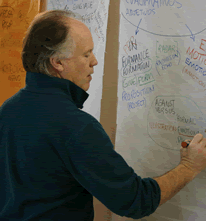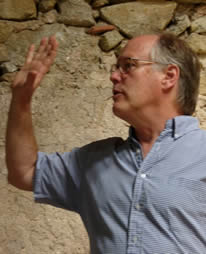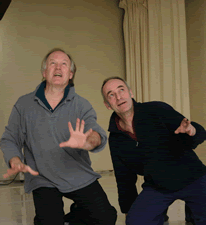Français
English
Español
Italiano
Portugués



Enrique Pardo |
|
FRANCAIS
Brève autobiographie (juillet 2018) CV Contexte artistique et intellectuel
Visitez mes BLOGS pour des mises à jour sur les idées et sur les projets, et bien sûr, proménez-vous sur ce site Video INTERVIEW 2018 Laboratoire Enrique Pardo
réalisation Didier Monge |
ENGLISH Below
Visit my BLOGS for updates on ideas and projects, and of course,
|
Présentation brochure 2018Enrique Pardo Metteur en scène, performeur, directeur de laboratoire, essayiste. La peinture et les beaux-arts furent mes premiers amours, mais dès 1968 j’ai viré de bord et suivi Roy Hart : gourou et « génie éthique ». Plus tard j’ai trouvé mon paysage philosophique avec James Hillman : un polythéisme contemporain de l’âme (Psyché). En 1981, j’ai créé Panthéâtre, avec le dieu Pan pris entre corps et images. Aujourd’hui je travaille surtout en laboratoire.
En résumé : ma recherche porte sur les fondements et les rouages psychologiques de la magie. Peut-être ce que le philosophe Xavier Papaïs appelle « une anthropologie de l’esprit ».
|
|
ARCHIVES Les notes biographiques (en anglais) qui suivent ont été écrites il y a quelques années. The following biographical notes were written some years back. Enrique Pardo, theatre director, performer, painter and writer, founded PANTHEATRE in 1981 with a now legendary solo performance on the god Pan: "Calling for Pan" (hence Pantheatre). This dance-theatre piece was a physical and vocal tour de force, a ritualistic and wild invocation of the singing-dancing God who embodies the borderline between animal and human - Pan, "with the goat feet and the two horns". The performance brought together the three main sources of Pantheatre: |
|
1 - The Voice: Enrique worked with Roy Hart and his theatre, joining the group in 1968 in London, training vocally with Hart and Liza Mayer, performing with the Roy Hart Theatre (before Roy Hart's death in 1975, and then till 1980), and pursuing a career as a vocalist-performer in contemporary opera and in several of his own theatre productions.
2 - Choreographic Theatre. Enrique trained in and incorporated different (and in many ways opposing) approaches to movement and dance. Firstly, corporal mime - the analytical exercices of Etienne Decroux - through numerous collaborations with Le Theatre du Mouvement (Claire Heggen and Yves Marc). Secondly: dance, with Dominique Dupuy, whom Enrique considers one of his masters, for his insight into such important areas as lyricism, narcissism, beauty, pleasure... And thirdly, the research on gesture and imagination elaborated by Eugenio Barba and his Odin Teatret - especially what could be described as the actor's "autogenic training": confronting and giving corporal form to (per-forming) one's fantasies.
3 - Myth. "Calling for Pan" was based on meetings with the late James Hillman and Rafael Lopez-Pedraza, as well as with Charles Boer, all three, authors of books on Pan and mythology and leading figures of archetypal psychology. James Hillman, who died on October 27, 2011, was the honorary president of PANTHEATRE and of its Myth and Theatre Festival. The PANTHEATRE LIBRARY is to a great extent dedicated to his work.
Beginning in 1981, these meetings led to a long and fascinating series of exchanges, joint seminars, tours (amongst these, the early Men's Movement conferences with James Hillman and Robert Bly), and to the creation in 1989 of the Myth and Theatre Festival. The relevance of mythology goes well beyond the theatrical and literal use of mythical figures or stories: myth refers here to a cultural dimension of image, implying the kind of image-based theatre that Enrique came to call choreographic theatre.
Enrique has performed and taught in Europe, North and South America, Australia and New Zealand.
Since 2000, Enrique has directed mainly performances by artists who have trained with PANTHEATRE ACTS. Most of these are documented on this site - see PERFORMANCES. Amongst them:
Some of the performances directed before 2000:
La Planque aux Anges (The Angels' Hideout) - adapted from Bernard-Marie Koltès' only novel: La fuite à cheval très loin dans la ville - for 5 dancers from the Pantheatre/Borderline Company, Paris. The Angel's Hideout - an article referring to this performance.
Rosenhell und Bildersturm - (Hell of Roses and Storm of Images). After attending the 1995 Myth and Theatre Festival, Marie Elliot Gartner wrote to Enrique Pardo asking him to direct a performance based on James Hillman's book "The Dream and the Underworld", with a theatre group she directed in Rosenheim, Bavaria (Yes, the Rosenheim of cult movie Bagdad Café). Enrique replied that the only way he could envisage such a project would be as a baroque "cabaret macabre". It was created in September 1997, with 14 actors, with original and adapted texts by Marie Elliot Gartner, who performed an indomitable Demeter who has trouble facing up to the fact that she now lives in her son in law's (Hades) night-club complex. She compensates with too many free martinis and wild theatrics. Influenced by Bavarian macabre folk stories - plus lots of exquisitely sweet Bavarian singing (one realizes, of course, that Mozart was suckled on Tyrolean and Bavarian harmonies), the performance is a long and exuberant funeral, with practically all the characters, at some point in the performance, being locked and forgotten in a coffin.
Shadow Boxing - a theatre cabaret, with 15 actors, the result of a workshop project produced by the Cambridge Drama Centre in April 1998. This was the result of a year-long project, "...designed to give participants both a workshop and a performing experience directed by Enrique Pardo. The 'cabaret' approach allows for radical artistic freedom, and plenty of humour; it encourages subversion and 'contra-diction'... The notion of "Shadow Boxing" gives the project an imaginal bent, calling up the hidden and darker side of things, where quality and temperament are revealed. "Without shadows, images remain flat and naive" (from the programme notes).
La Maison dans les Airs after "Love and Other Demons" by Gabriel Garcia-Marquez, adapted by story-teller Guylaine Kasza-Peyronnet, with accordionist Robert Santiago and three Colombian musicians. Created on December 13th 1998, at the Dinan Festival (Britanny).
Jason and Medea / POSTMORTEM - by MIMANDIROSE ENSEMBLE, produced by Giovanna Lue, Milan, for six actresses. Created at the CRT Theatre in Milano. Medea / Milano presentation + A video is now available
GREED : The Bacchae Project - New York, May 20th 1999 - by Local 116 Ensemble, from Columbia University. With Texts by Aida Croal. Check GREED.
The Shakespeare Betrayal : written and performed by Kristin Linklater, with 5 actor. Work in progress presentations, New York, June 16 - 18.
Pandora's Box : by Pantheatre UK Company. A performance project with 6 actors-directors, produced in collaboration with Angela Bullock (Twisted Stocking Company), and Dan Skinner (Rose Theatre Company), including Nick Hobbs, Faroque Kahn, Kirstin McIver and Zoé Crowder. Check Pandora's Box.
Enrique est né à Lima, au Pérou, en 1946, dans une famille hispano-créole bien établie avec de solides liens francophiles. Il a passé son enfance au Pérou avant de déménager avec sa famille en Europe, passer son baccalauréat français à Paris, étudier le droit et l'économie à Madrid. Il obtient un diplôme de peinture à la Chelsea School of Art de Londres puis enseigne les beaux-arts au Goldsmith College, Université de Londres.
Ses meilleurs étudiants de l'époque (la fin des années 60) se tournaient déjà vers ce qu’on appelle performance art, et produisaient des œuvres qu'il trouvait souvent plus intéressantes que son propre travail de peinture. Cela le conduisit au théâtre (il avait 26 ans à l'époque) et à travailler avec Roy Hart et le Roy Hart Theatre - un changement de fond dans ses implications personnelles et culturelles. En plus de jouer et de diriger, il a, au fil des ans, commencé à enseigner la voix dans le modèle "Roy Hart". Le modèle de singing lesson (leçon de chant ) en tête-à-tête, tel que pratiqué par Roy Hart et ses disciples, peut être très proche du modèle de «transfert» psychanalytique. Mal à l'aise avec certaines des implications, en particulier l'utilisation potentiellement ambivalente de la thérapie, Enrique arrêta d'enseigner pendant plusieurs années. Il a entamé alors de longs dialogues avec des psychothérapeutes – une troisième éducation - qui a conduit à sa rencontre avec James Hillman et Rafael Lopez-Pedraza, ainsi qu’avec Charles Boer, Paul Kugler, Ginette Paris, Nor Hall, Sonu Shamdasani et le cercle de psychologie archétypale (post-junguienne) qui devait inspirer son travail et Panthéâtre. C'était à la fin des années soixante-dix et au début des années quatre-vingt. Aujourd'hui, avec beaucoup de ses collaborateurs, il insiste sur le fait que c'est notre esthétique, nos modes de perception et d'appréciation, nos idées politiques et culturelles qui ont besoin de thérapie. D'où l'accent mis sur les défis mytho-poétiques et intellectuels, dans un travail par ailleurs très corporel et imaginatif.
"Enrique Pardo est le professeur dont vous avez toujours rêvé: tout à fait à l’aise dans le langage des images et de psyché, maître de la surprise et de la subversion, il va droit au cœur de ce qui compte: dans ses ateliers il est un joyeux alchimiste qui chauffe vos fantasmes et apports artistiques jusqu'à ce que vous et votre matériel soyez transmués. Un travail très exigeant et franchement délicieux ... " Nor Hall, auteur et psychothérapeute.
"Il pille la mythologie grecque et l'alchimie à la recherche d'inspiration et embarque ses disciples vers de nouveaux territoires, franchissant les frontières pour aller moissonner des trésors iconoclastes. Les artistes, toutes disciplines confondues, brisent de vieilles habitudes et lèvent les inhibitions, pour découvrir un nouvel élan et le courage physique et vocal pour exercer les muscles de l’imagination. Les metteurs en scène verront la scène avec de nouveaux yeux et entendront les textes avec de nouvelles oreilles." Kristin Linklater, Directrice émérite de Théâtre, Université de Columbia, New York.
Enrique was born in Lima, Peru, in 1946, in a well-established Spanish-creole family with strong francophile connections. He spent his childhood in Peru before moving with his family to Europe, passing his French baccalauréat in Paris, studying law and economics in Madrid, graduating in painting from Chelsea School of Art, London, and teaching Fine Arts at Goldsmith College (University of London).
His best students at the time (the late 60s) were involved in performance art, and doing work that he considered much more interesting and fun than his own painting work. This led him to theatre (he was 26 then) and to working with Roy Hart and the Roy Hart Theatre - a move with many personal and cultural implications. As well as performing and directing, he started teaching voice within the "Roy Hart" model. The one-to-one "singing lesson" model, especially as practiced by Roy Hart and his followers, can be very close to the psychoanalytic 'transference' model. Ill at ease with some of the implications of this model, especially the potentially ambivalent use of therapy, Enrique stopped teaching for some years, and started the long dialogue with psychotherapists that led to his meeting with James Hillman and Rafael Lopez-Pedraza, as well as Charles Boer, Paul Kugler, Ginette Paris, Nor Hall, Sonu Shamdasani and the archetypal psychology circle that was to inspire Pantheatre. This was in the late seventies and early eighties. Today, along with many of his collaborators, he would insist that it is our esthetics, our modes of perception and appreciation, our political and cultural ideas that need therapy. Hence the accent on mytho-poetical and intellectual challenges, in an otherwise very corporal and imagistic work.
"Enrique Pardo is the teacher you've always dreamed about. Steeped in the psyche's language of image-making, master of surprise and subversion, he puts his finger on the heart of what matters. In workshops he's a gleeful alchemist who heats your material until it, and you, come out transmuted. Ultimately demanding and utterly delightful…" Nor Hall, author and psychologist
"He plunders Greek mythology and alchemy for inspiration and his followers travel over new territory, breaking boundaries, crossing new frontiers and reaping iconoclastic rewards. Performers from all disciplines will break old habits and dissolve inhibitions, discover physical and vocal courage and stretch their imaginative muscles; directors will see the stage with new eyes and hear the text with new ears." Kristin Linklater, Chair of Theatre, Columbia University.